As an Amazon Associate I earn from qualifying purchases.

Corning venison began as one of those, “why not?” experiments that turned out far better than I had expected. I don’t know why I was so worried — I like corned beef, and how different is venison, anyway?
Corning venison at home is so good in fact that any deer hunter out there really ought to learn this technique — you will get far more enjoyment out of the leg roasts from your venison.
I typically use whole-muscle roasts from the hind leg to do this. Big sirloin roasts, rump roasts, the “football roast,” and such. But any big hunk of venison will work. The advantage of the whole-muscle roasts is less sinew and connective tissue, which takes hours to break down. I suppose you could use the backstrap, but why would you?
Lovers of hash might want to corn shoulder or neck roasts, then simmer them so long they begin to fall apart. The extra connective tissue in these cuts makes for a moister hash.

The technique is simple: Brine your meat, then simmer it into tenderness. It takes several days, but it isn’t labor-intensive at all. Once made, corned venison is great hot or cold, with root vegetables, cabbage, cold in sandwiches (how I eat most of my corned venison), or chopped into hash.
A word on nitrites. I use them, for color, for flavor and for safety. Can you do this without pink salt? Yes, but your meat will be gray, you will lose some flavor, and there is an ever-so slight chance you might pick up botulism — not a large chance, but as botulism is one of the most toxic substances known to man, I’d say use the nitrite. You can buy it online here at The Sausage Maker.
Once made, you can keep corned venison in the fridge for a couple weeks, or freeze it for a year.
Corned Venison
Ingredients
- 1/2 gallon water
- 1/2 cup kosher salt
- 1/3 cup sugar
- 1/2 ounce Instacure No. 1 (sodium nitrite)
- 1 tablespoon cracked black pepper
- 1 tablespoon toasted coriander seeds
- 6 bay leaves, crushed
- 1 tablespoon mustard seeds
- 1 tablespoon dried thyme
- 1 teaspoon caraway seeds
- 1 cinnamon stick
- 5 chopped garlic cloves
- A 3 to 5 pound venison roast
Instructions
- Add everything but the roast to a pot and bring it to a boil. Turn off the heat and cover, then let it cool to room temperature while covered. This will take a few hours. Meanwhile, trim any silverskin you find off the roast. Leave the fat. Once the brine is cool, find a container just about large enough to hold the roast, place the meat inside and cover with the brine. You might have extra, which you can discard.
- Make sure the roast is completely submerged in the brine; I use a clean stone to weigh the meat down. You can also just flip the meat every day. Cover and put in the fridge for 5 to 7 days, depending on the roast's size. A 2-pound roast might only need 4 days. The longer you soak, the saltier it will get -- but you want the salt and nitrate to work its way to the center of the roast, and that takes time. Err on extra days, not fewer days.
- After the alloted time has passed, you have corned venison. To cook and eat, rinse off the meat, then put the roast in a pot just large enough to hold it and cover with fresh water. You don't want too large a pot or the fresh water will leach out too much flavor from the meat -- it's an osmosis thing. partially cover the pot and simmer gently -- don't boil -- for at least 3 hours and up to 5 hours. The meat itself will be cooked in an hour or less, but you want the sinews and connective tissue in the roast to soften and that takes time.
- Eat hot or cold. It is absolutely fantastic with good mustard and some sauerkraut on a sandwich.
Notes
Nutrition
Nutrition information is automatically calculated, so should only be used as an approximation.

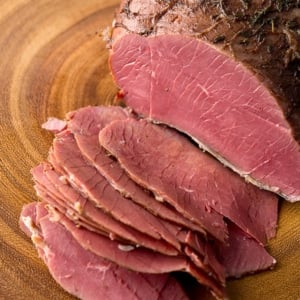
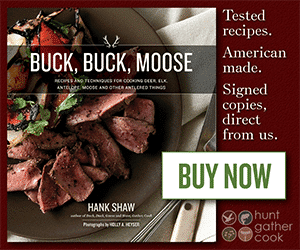


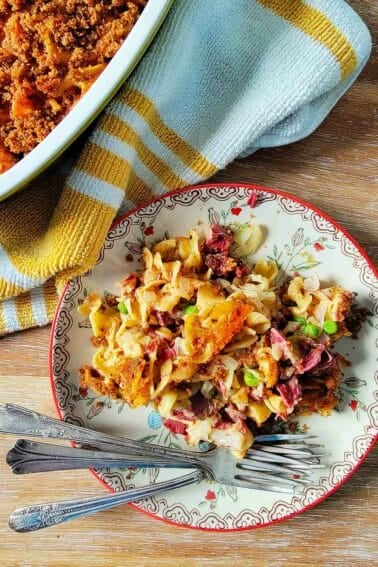
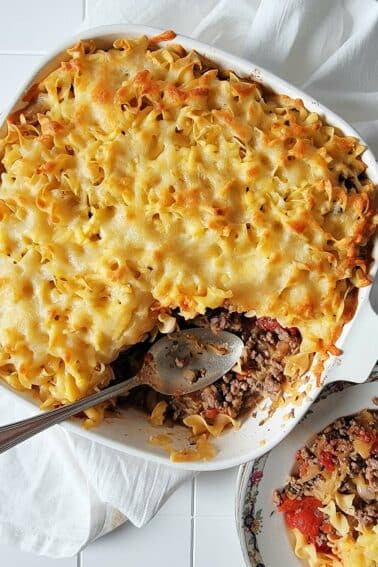
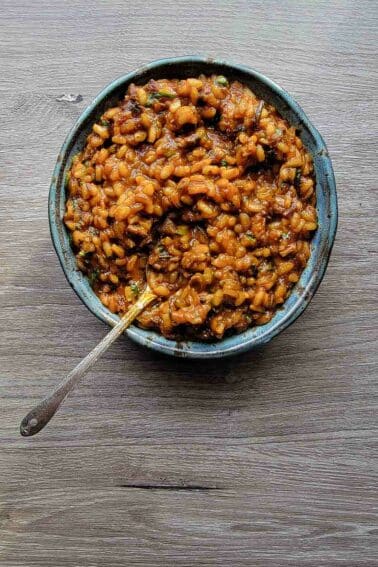
It’s funny but my Dad tried so many recipes when I was living with my parents. Corned venison was one of them. Dad used a brine of salt, Prague Powder (Instacure #1–he bought it by the pound from The Sausage Maker), and mixed spices. I remember coriander seed, mustard seed, whole thyme leaf (fresh preferred), broken cinnamon sticks, allspice berries, juniper berries (when we had them), minced dried garlic, and fennel seed. We made it often since Mom loved it; she said it was a nice change from plain venison roast. Dad always said his problem wasn’t running out of things to do with venison; it was running out of venison to work with! Even after becoming disabled Dad hunted to the limits of his licenses so we always had game meat in the freezer. Friends would even bring Dad parts of their own kills they didn’t want because they knew Dad would use it all!
Which brings me to something I think you and your other readers can use. When Dad was first processing deer, we had a guy come in with two deer who asked us how we did the necks. Dad answered him honestly that we did the entire deer the way the client wanted. He then asked us to bone out the necks as one piece of meat and roll and tie them as roasts with “this” inside. “This” turned out to be a three pound butter tub of slivered garlic, chopped onion, juniper berries, and dried fennel fronds. He explained that they liked to slow cook the neck roasts since they really didn’t like venison burger. (He’d asked that the ground venison be made into sweet Italian sausage.) Dad looked at the tub full of seasonings, then asked if he wanted us to season and tie other roasts if we had left over seasonings. He agreed. I could tell Dad had an Idea! and he did. He ground the seasons into a coarse paste that he spread on the inside of the neck meat before he tied them, then deboned one of the shoulders, spreading the ground seasonings on the inside before he tied that up as a roast. Then he deboned a rump roast and spread it with the last of the seasonings and tied it. The guy came back the next year with more of the seasonings and asked us to make up as many roasts that way as we could. Dad charged him an extra 25 cents per pound for doing the roasts that way (we charged 50 cents per pound of sausage and we supplied the seasonings) and he kept coming back for nearly a decade until he moved away. I hope wherever he went, he found someone to do his roasts the way he wanted.
This recipe is off the hook! Next time I will go the full 7 days. I pulled my 3 lb roast out on day 5 and there was still a slight tinge of gray in the middle. I used tenderquick instead of instacure, so maybe that’s the difference? IDK, it was still exceptional and I’m still alive. Definitely will make this again!
I made this with a whitetail roast and finished it for 75 minutes in a instapot. Delicious. Thanks
Instead of simmering in water, could I sous vide in a lager? If so, what temp would work? I’m using dry aged whole muscles from the hind quarter.
Thanks,
Ted
I had the same idea. I’m thinking 195 – that’s where I’d want a pork shoulder or brisket to soften all the connective tissue.
Hank, this recipe is fantastic — a generous gift from you (have been using it from Buck, Buck, Moose). A New York Times recipe for corned beef brisket substitutes good beer and good ginger beer as the cooking liquid. Any thoughts? Or, if you like the idea, a beer style recommendation? Thanks!
Finally getting back on this — I used 2 parts Guinness Stout to 1 part water for the gentle simmer, and it was excellent! Great Lakes Brewing suggests using their Conway’s Irish Ale — I may try that, as well.
This was an easy recipe to follow and turned a venison roast into a well-seasoned, delicious piece of meat. The toasted coriander seeds came across a touch strong for our taste, I’ll reduce those a bit the next time, but we’ll be making this again.
After a 7 day soak in the brine, we simmered it for 4 hours then added cabbage, potatoes, carrots and onions and simmered another hour or so until they were done. Beautifully tender. Can’t wait to make sandwiches with the leftovers tomorrow. Thanks for a great recipe!
could you shave a day or so off the brine time if you injected the roast with some of the brine?
I’ve been making your corned venison for years so good and I passed it on to some of my friends ps also chipotle venison jerky is big hit
Hank – Could I use 4 or 5 TBSP of pickling spice in lieu of coriander seed, mustard seed, etc.?
I have used pickling spice in lieu of all the individual ingredients for the last couple years….it works very good…I used to omit the thyme I felt it imparted a medical taste…the pickling spice I use doesn’t have it
Thanks for the feedback Carl. Mines been brining for about 5 days now. Going make it in the Zavor Pressure Cooker.
Of the pot to brine in- my Mom always used an enamel rectangular one with a slide on lid. Wish I still had it. I did some reading and found one should use only steel or enamel re chemical reaction. I also now place my meat and brine in a white plastic kitchen grade bag, take the air out , knot it and place in container in fridge. Easier to flip daily. Meat is constantly submerged.
I have also used this brine or similar to make meat into pastromi be it deer or goose breasts – following your pastromi brandy and spice rub before smoking recipe. it turns our great.
I have tried your dry pack method for curing pastromi but prefer the brine.
So is it correct to say that your brine recipe could be made into pastromi if smoked rather than simmered into corned beef or have I missed something.
Thanks for all your inspiration.
For corned venison I usually use the eye of the round, which is far leaner than a beef brisket but cooks well in Reubens and hash. Riffing on a recipe for Wild Turkey Hash from a wonderful spot in Manchester, NH called Up For Breakfast, i make a sweet potato corned venison hash. Onions, pine nuts—Yum!
Can this be done of with frozen meat?
Janie: Yes.
I make this frequently with elk roasts. the recipe is perfect. The meat is always tender and perfectly pink and delicious.
Is it ok to let the brine cool by placing it outdoors for a bit? Just to speed up the cooling process?? Or is there something going on in there that would be better suited to the slower cooling? Just wondering… Thanks!
Joseph: Yes, you can do that.
Hi Hank,
I am thinking of adding some allspice, cloves, and ginger to the recipe. I enjoy those flavors, but don’t want to upset the balance. What do you think?
Jeremy: You can do that if you want.
Once it is corned, now how to make corned venison and cabbage?
Can i make it in a crock pot like i would corned beef and cabbage?
Thomas: Yes.
I make a lot of corned goose, duck and beef. I would like to corn a whole deer hind qtr. I question if the longer soak will make it too salty. I want to leave the bone in. Any advice?
Thanks very much, my late Dad and late Uncle didn’t leave any recipes, they did it all from memory and my cousin is due to visit me with a chunk of venison I want to fix up
I feel like this could be a killer sous recipe. Just seal it up at the beginning and no air contact throughout. Would it be inadvisable to cook in the brine? I have no idea. I guess you could drain then add a little fresh. Looking forward to using this soon!
It has been recommended to me that for a thicker cut of Venison (say, an entire sirloin roast with all of the interior layers of connective tissue), that I wet-brine or Corn the roast instead of dry curing it. Have you ever used this method for curing the meat, but then smoked the meat (instead of boiling it) like you suggest in your Venison Pastrami recipe?
Patrick: Yes, I have. I generally use a ratio of 1/4 cup Diamond Crystal kosher salt to 1 quart of water. That works well. You can brine the meat for more than a week that way, in the fridge.